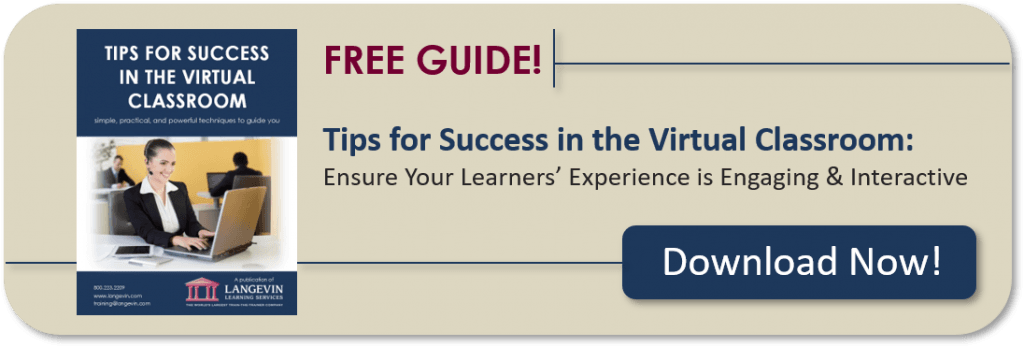Photo by: yacobchuk via Canva
Coping with challenging participants is certainly not a new topic. In fact, you’ll find numerous blog articles written by my colleagues (and myself, for that matter) on handling challenging situations in a traditional classroom setting. But what about dealing with difficult learners in a live, online, synchronous environment or virtual classroom?
How you respond to a challenging behavior can make the difference between a healthy, collaborative learning experience and an awkward, uncomfortable session everyone wants to escape. While many of the coping strategies are the same for instructor-led training and virtual classroom training, there are some subtle differences.
Based on my own experience in the virtual classroom, I’ve put together a few tips to help you manage challenging participants and situations:
1. Separate the “what” from the “why.” Instead of focusing on what the learner is doing, ask yourself why they’re doing it. Do they want to be recognized as an expert? Do they seem frustrated because they can’t use the technology? Do they wish they were back at their desk finishing a project by its deadline?
Once you’ve done this separation, acknowledge the underlying need with a positive comment. For example, “You obviously have a lot of experience in this arena,” or “For someone new to the virtual environment, you’re getting a handle on this pretty quickly,” or “I know you have a lot on your plate, so let’s make sure this session is productive.”
If you’re not using webcams in your virtual classrooms, it’s even more important to be mindful of your tone of voice. You don’t want to come off sounding aggressive or threatening.
2. Thank a challenging participant for their insights, questions, and observations with comments like, “That’s a great question,” or “I’ve never thought of it that way before,” or “That’s a good point. Let me capture your thoughts on the parking lot, and we’ll come back to it at the end of our session today.”
Oftentimes, you’ll find they’re the first ones to log out of the classroom. They don’t want to engage with you one on one, they just want to call attention to themselves in front of the group. I always tell newer trainers, “Harness the experience of your adult learners, or it will harness you!” And it’s not always in a good way.
3. Provide numerous opportunities for active participation. Challenging behaviors can be amplified when learners are bored or disinterested. Use the tools and features available to you in your virtual classroom platform. Things like polls, chat pods, breakout rooms, and the whiteboard and annotation tools can be extremely effective in keeping your attendees engaged.
One of my favorite things to do is to ask my learners to enter an emoji in chat that represents their learning experience so far. If I’m facilitating a multi-session course, I do this at the end of the first session. That way, if I get any indicators of a negative experience, I can take steps to mitigate it.
4. Keep your sense of humor intact. An easy laugh and a willingness to playfully handle a difficult participant’s challenging comment can relax a stressful situation. I’ve found that some participants respond well to playfulness and the ability to laugh things off.
5. Use effective questioning techniques like the “Five Whys” method to get to the root cause of the behavior. This can be done in private in a breakout room post-session. Encourage them to explain why they feel the way they do, don’t interrupt them while they speak, and keep on asking questions until they’ve fully explained the situation.
6. Set ground rules using the 4 E’s. I do this at the beginning of every course. Encourage participation by showing your attendees how to use the raise hand button and chat pod. It’s important to give learners a platform to contribute. It reduces the likelihood of disruptive behaviors and cultivates a sense of ownership over the learning process.
Engage learners every three to five minutes in the virtual classroom. I find my attendees don’t have time to be disruptive if I keep them busy.
Establish clear expectations early on, so that attendees know what they’re in store for during the course. We know adult learners like to know where they’re going and how they’re going to get there.
Lastly, early intervention is key if someone is disruptive. If you ignore it, not only do the other attendees suffer, but your credibility is negatively affected.
7. Enlist your Producer, especially if you have a large group. Having a second set of hands can be hugely helpful in managing disruptions. Your producer can put ground rule reminders in the chat pod to promote reinforcement, mute/unmute a noisy attendee, put page numbers in chat, or communicate with an attendee via private chat or in a breakout room.
Try to see things from the participant’s perspective as they express their feelings. Use active listening techniques, like paraphrasing and reflection of feelings, so they feel acknowledged and understood.
Despite their contrary behavior, challenging participants usually want to be included in a collaborative, productive learning community. By drawing them in, instead of shutting them down or pushing them away, you can enrich the learning environment for everyone. If these simple, effective strategies don’t work, you can always speak to the participant one-on-one after the session, as mentioned above, or turn it over to your Producer/Co-Facilitator to explore via private chat.
What tips and tricks do you have for managing challenging behaviors in the virtual classroom? Please share your ideas!
For more tips on separating the problem behavior from the learner and deciding when to intervene (and when not to), check out The Virtual Trainer. This workshop will show you how to leverage, adapt, and transition your skills and experience as a traditional classroom trainer to the virtual classroom.
This article was first published April 6, 2015.


